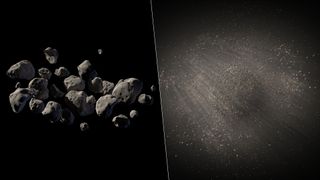
Near-Earth asteroids are similar to time capsules, holding secrets to the early history of the solar system, experts say. Temporary companions called ‘minimoons’ may be the best place to unearth these secrets.
(Image credit: NASA/JPL-Caltech)
The solar system holds many secrets that scientists are still trying to unravel. To help shed light on these mysteries, researchers are turning to space rocks of all kinds that may hold clues to the lost story of our solar system’s past. This approach is already bearing fruit: In October 2023, NASA’s OSIRIS REx mission discovered water and carbon — two of the precursors for life on Earth — on the 4.5 billion-year-old asteroid Bennu.
Among the thousands of asteroids swarming near Earth’s orbit, minimoons — tiny cosmic bodies, whose orbits are partially governed by Earth and partially by other solar system bodies — may be prime candidates for learning about the origins of the solar system, said Richard Binzel, a professor of planetary sciences at the Massachusetts Institute of Technology.
“[Minimoons] probably have had a bit of a pinball experience in the inner solar system, being ricocheted around and tugged on by the different planets,” Binzel told Live Science. “They finally found themselves in a way that they got tugged into a somewhat circular orbit near the Earth.”
Minimoons’ relatively close proximity to Earth means traveling to them and grabbing a sample would take much less time and fuel than it would to get to asteroids like Bennu. Although scientists aren’t yet sure where minimoons came from, a leading theory suggests they originated in the main asteroid belt, which is located between Mars and Jupiter.
Near-Earth asteroids from this region, such as Bennu or a minimoon, are “like time capsules,” Paul Abell, chief scientist for small body exploration at NASA, told Live Science. “They give us indications of what the early solar system was like [and] what the conditions were.”
For example, in 2019, the Japan Aerospace Exploration Agency (JAXA) retrieved samples from the diamond-shaped asteroid Ryugu, located more than 200 million miles (322 million kilometers) from Earth. Later analysis revealed that the space rock contains stardust that predates our solar system, as well as “prebiotic organics,” including several amino acids used by living beings to build proteins that form things like hair and muscles.
Collecting samples from minimoons could help mitigate some big problems in current asteroid research. In most cases, scientists study chunks of asteroids that have fallen to Earth in the form of meteorites. These can still teach us about the solar system’s early composition, but they may be difficult to analyze depending on the condition they are found in, Abell said.
“When we have a meteorite falling on Earth, it’s already contaminated” by moisture and gasses in Earth’s atmosphere, he said. “When you’re talking about organic molecules and water — more volatile type materials — going to the source and figuring out what’s there is really important. That’s why we’d like to do these sample return missions, like OSIRIS REx.”
The OSIRIS-REx spacecraft dropped the Bennu sample off on Earth in September, completing NASA’s first successful mission to collect samples from a far-flung asteroid. The rocket is now on its next mission to explore the asteroid Apophis and is expected to arrive in 2029 when the cosmic rock passes within 19,800 miles (31,865 km) of our planet.
NASA will continue to study the rocks and dust within Bennu over the next decade because “the bounty of carbon-rich material and the abundant presence of water-bearing clay minerals are just the tip of the cosmic iceberg,” Dante Lauretta, OSIRIS-REx’s principal investigator, said at a news conference in October.
For now, the success of the OSIRIS-REx mission has inspired scientists planning the next phases of near-Earth exploration — and the next easiest destination could be a minimoon, experts say.
Get the world’s most fascinating discoveries delivered straight to your inbox.
Kiley Price is a former Live Science staff writer based in New York City. Her work has appeared in National Geographic, Slate, Mongabay and more. She holds a bachelor’s degree from Wake Forest University, where she studied biology and journalism, and is pursuing a master’s degree at New York University’s Science, Health and Environmental Reporting Program.
>>> Read full article>>>
Copyright for syndicated content belongs to the linked Source : Live Science – https://www.livescience.com/space/asteroids/earth-has-extra-moons-and-they-may-hold-the-secrets-of-our-solar-systems-past































